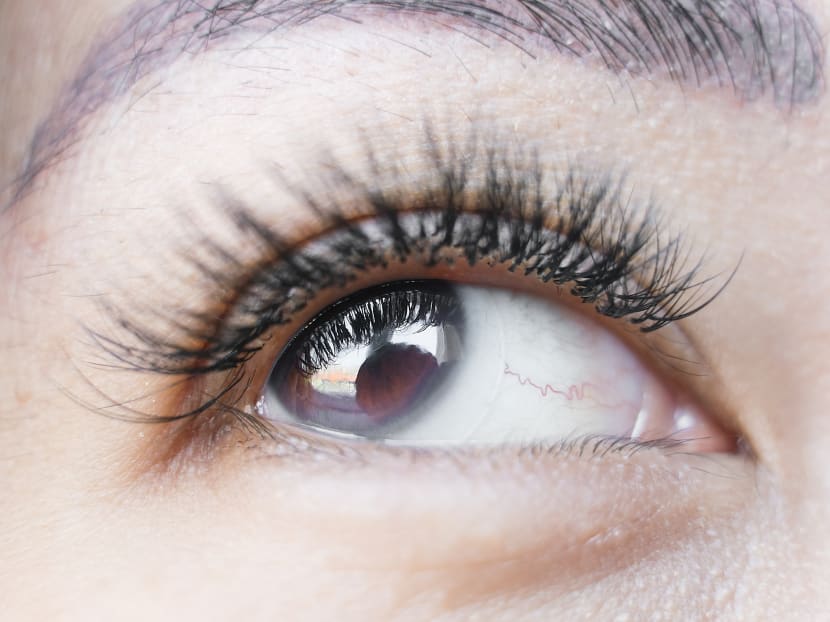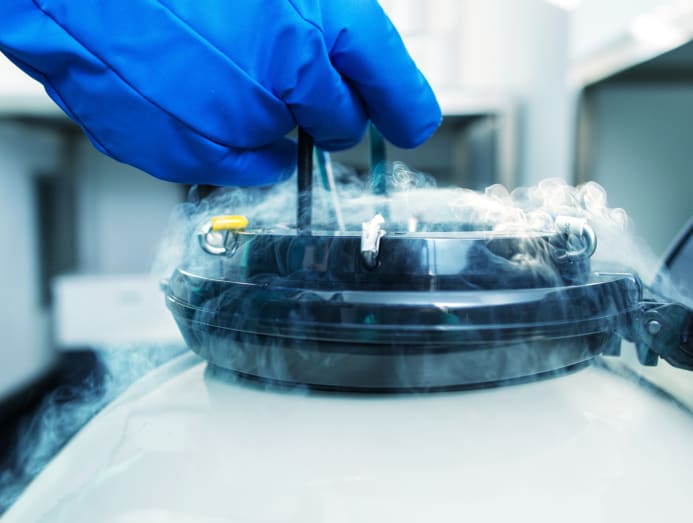Worried about 'lao hua' later in life? You can now store eye tissues for the future
Advertisement
Wellness
Worried about 'lao hua' subsequently in life? You can at present store eye tissues for the time to come
Yes, you read that right. The corneal tissues removed to correct your shortsightedness can at present be kept just in case you develop presbyopia. But what if you've already done LASIK?

(Photo: iStock/Enes Evren)
22 Oct 2022 07:09AM (Updated: 25 October 2022 09:28AM)
Picture this: You've had laser surgery before where the eye physician removed slivers of tissue from your corneas to fix your shortsightedness (it's non LASIK simply hold your horses). And voila, everything's as clear every bit day again.
Only then, further down the road, as you lot arroyo your 40s, y'all've got some other medical issue to worry about: Presbyopia or "lao hua" ( the gradual loss of your eyes' ability to focus on nearby objects) .
What if those middle tissues – medically known as corneal lenticules – that were taken out years agone (and thrown away) could actually be stored and used again to fix your future problem?
What sounds similar something from a science-fiction moving picture is really possible right at present in Singapore, courtesy of a new technology and an actual identify where you tin can "banking company" those eye tissues.
The latter is a corneal lenticule banking service called OptiQ. Meanwhile, 2 doctors from the Singapore National Eye Centre's (SNEC) research arm Singapore Eye Research Institute, Professors Donald Tan and Jodhbir Mehta, take invented a applied science to re-implant those bits of cornea back into the optics to correct "lao hua".
Sounds like good news for this nation of myopics (82 per cent of 20-year-olds in Singapore suffer from myopia), who are pretty big fans of light amplification by stimulated emission of radiation eye surgery, considering more than than 500,000 LASIK procedures were done at the SNEC over the last 20 years.
Only how does this actually work? CNA Lifestyle finds out.
WHAT DOES LASER EYE SURGERY At present Accept TO Exercise WITH 'LAO HUA' LATER?
It has to do with the lens-shaped corneal tissue the doctor removes to re-contour the cornea and correct shortsightedness. (Again, this is not LASIK, which we'll explain in a bit.)
These corneal lenticules can be re-implanted dorsum into the optics to right not just presbyopia, just also hyperopia (farsightedness) and certain center conditions such every bit keratoconus (the abnormal shaping of the cornea).
What's interesting is that the removed corneal tissue will be used similar a corrective lens; for instance, if you have 300 degrees of myopia, the extracted lenticule will provide a corrective power of 300 degrees. It'due south like recycling $.25 of yourself.
It'LL Exist YEARS UNTIL I Accept AN ISSUE WITH PRESBYOPIA, And then WHERE DO MY EYE TISSUES GO?
That'south where OptiQ comes in. What they'll do is cryopreserve the corneal tissues at temperatures below -150 degrees Celsius. In other words, they're put in a freezer for future use.
OptiQ was recently opened in March this year by Cordlife. The Ministry of Health-licensed service is from the same company that'south been offering stem prison cell banking services in Singapore since 2001. In fact, OptiQ leverages on Cordlife'southward biological tissue storage facilities.
WHAT IF I'VE ALREADY HAD LASIK?
You won't be eligible because the creation of a flap on the cornea during LASIK makes it unsuitable to later extract tissue from it, said Prof Mehta. A quick recap: The flap opens up the cornea and allows the light amplification by stimulated emission of radiation to reshape the eye's contours. The flap is so closed back and stitched to concur it in identify.
In the starting time place, LASIK doesn't involve any tissue extraction to right myopia or astigmatism, then it isn't a suitable procedure if you're considering freezing your corneal tissues.
At the moment, the Grin (short for Small Incision Lenticule Extraction) process is suitable and is offered at the SNEC. To correct myopia and astigmatism, it removes a fleck of tissue through a small keyhole to reshape the cornea. (Run across the Instagram mail service below for illustration.)
To ascertain your eligibility for Smiling, yous'll have to undergo a refractive cess and be screened, said Prof Mehta. "Those who aren't eligible are those below the age of 21, those with unstable myopia or certain heart pathologies, pregnant women and people on certain oral medications," he said.
At the moment, almost 30 per cent of SMILE patients who are interested in lenticule cyberbanking opted for OptiQ , said Tan Poh Lan, the grouping CEO of Cordlife.
WHAT'S THE STORAGE Price AND FOR HOW LONG?
At that place are two payment options to consider: Upfront and an annual plan. The former is available for S$4,500 and covers 20 years of storage. "If both the lenticules are utilised, the remaining cost of storage volition be waived," said Tan.
The yearly plan consists of a ane-off payment of S$1,800 forth with an annual fee of S$180 for the next 19 years of storage. (That'southward a total of South$5,220, if y'all do the math.)

Although the duration is 20 years, you can cull to proceed storing the corneal lenticules across the period since presbyopia's onset is about certain to hit around 40 years of age, said Tan. Moreover, there isn't a use-by date for the lenticules.
Similar to laser center surgeries (be it LASIK or Grin), the storage cost is non covered by insurance or Medisave.
HOW Practise THE EXTRACTED CORNEAL TISSUES CORRECT PRESBYOPIA?
Each corneal tissue or lenticule is cutting convex-shaped when it was starting time removed, so that when it is re-inserted like a patch, it flattens the central cornea. This changed shape, in plough, enhances near vision to correct presbyopia.

WHAT'S THE SUCCESS RATE OF PUTTING THE CORNEAL TISSUES BACK?
The implantation is yet being researched on but in one case it becomes standard therapy for presbyopia, it will provide those who have stored their corneal lenticules more treatment opportunities.
In the meantime, the SNEC has performed two implantations so far, said Prof Mehta, who cited COVID-19 restrictions as the reason for the low number of cases, although "nosotros accept people on the waiting list".
"The success charge per unit, based on our feel and that from medical literature, has been high, over 95 per cent," he said, adding that the use of keyhole surgery, sterile techniques and topical antibiotics help to continue infection rates low.
These biological corneal inserts have some other advantage: A lower risk of scarring, said Prof Mehta, which can be as loftier every bit 10 to forty per cent when artificial ones are used instead.
T he biological ones are also less likely to be rejected by your body and lead to complications such every bit corneal haze, which causes your cornea to plow cloudy or opaque.
Currently, merely the SNEC is equipped and has the intellectual holding rights to perform the implantation.
Tin IT BE REVERSED?
Should the implanted corneal tissue need to be removed, it tin can be done without causing lasting effects, said Prof Mehta. " The primary medical event is to ensure that the donor has been properly screened for possible infectious diseases," he added.
Recent Searches
Trending Topics
Source: https://cnalifestyle.channelnewsasia.com/wellness/optiq-lasik-eye-surgery-lao-hua-presbyopia-285106

0 Response to "Worried about 'lao hua' later in life? You can now store eye tissues for the future"
Post a Comment